In insurance, every customer has unique needs, risks, and coverage requirements. Each interaction has to be personalized to ensure they get the right plan.
However, qualifying customers and answering the same questions day in and out is unsustainable for your agents, and stalls business growth. This is why many insurance companies are turning to AI-driven support to improve their overall efficiency.
However, integrating chatbots into your insurance business may come with challenges. Maintaining data security, providing accurate responses for complex policies, and balancing automation with personalized service are key concerns.
Despite these hurdles, many insurers are successfully adopting chatbot technology to improve service and streamline operations.
In this article, we’ll explore real-world examples and use cases that highlight the impact of insurance chatbots. We’ll also present the challenges companies may encounter along the way and show you how to solve them, so stay tuned.
Benefits of insurance chatbots
Insurance chatbots are AI-powered virtual assistants that help insurance companies automate customer interactions, from answering policy questions to processing claims. They improve efficiency by providing instant support, reducing the workload for human agents, and enhancing the overall customer experience.
They can be used on the channels your customers rely on most, like your website, WhatsApp, Facebook Messenger, Instagram, and more. They help you handle high volumes of inquiries, reduce claim processing times, and provide policyholders with accurate information without the need for human intervention.
Here are more key benefits of AI for insurance agents:
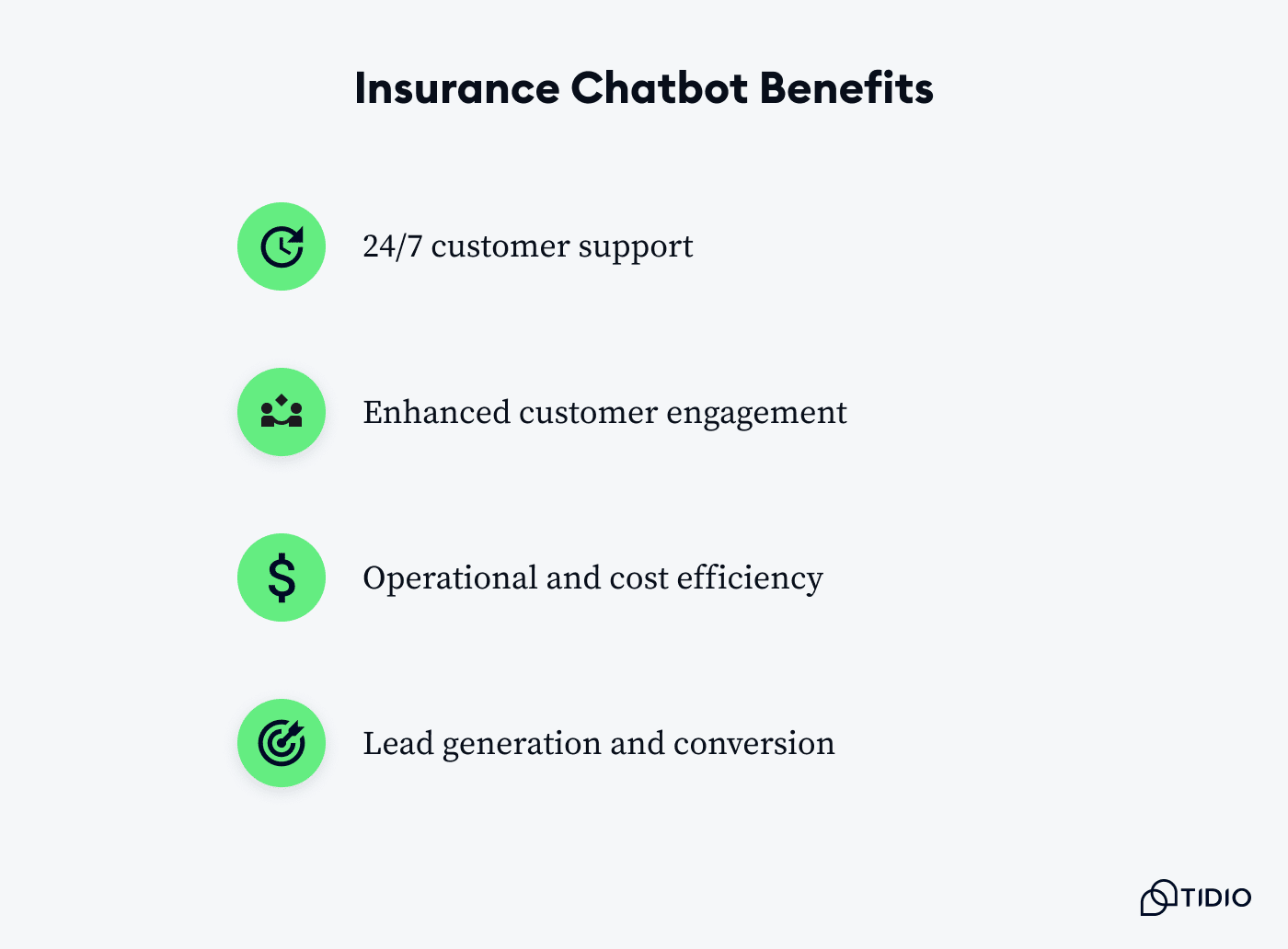
24/7 customer support
Accidents can happen at any time. Chatbots ensure that your policyholders get help whenever they need it, whether it’s late at night or while on vacation.
From answering policy questions to assisting with claims, chatbots for insurance provide immediate responses, eliminating long wait times and keeping customers satisfied.
In fact, these bots can handle up to 80% of inbound inquiries, allowing insurers to provide consistent, round-the-clock support without overwhelming human agents.
Enhanced customer engagement
By offering personalized interactions and quick replies, chatbots in the insurance sector keep customers engaged and build stronger client relationships.
For example, they can recommend insurance plans based on customer needs, explain policy details, and even provide helpful tips, creating a more tailored experience for each user.
In fact, 83% of customers are happy chatting with insurance chatbots, which shows their solid potential to improve client engagement.
Operational and cost efficiency
Handling routine inquiries like checking policy details or updating contact information can take up a lot of time for human agents. Chatbots handle these repetitive tasks, allowing agents to focus on more complex issues.
Beyond improving efficiency, AI-powered chatbots significantly reduce costs. Hiring and training new agents is expensive, with ongoing costs for salaries, benefits, and turnover. In contrast, a chatbot provides 24/7 support at a fraction of the cost, scaling instantly to handle high inquiry volumes without hiring additional staff.
According to our own chatbot study, chatbots deliver an average ROI of 1,275%, driven primarily by support cost savings alone.
Read more: Want to see how much you could save? Use our ROI calculator to estimate your potential cost reductions with Tidio.
Lead generation and conversion
Insurance chatbots can do more than assist your existing customers—they can also help attract new ones. By collecting basic details from website visitors or app users, chatbots gather leads for your sales team.
Plus, they can answer questions and guide new customers through quotes, policy comparisons, and application processes, increasing the chances of conversion.
Read more: Find out more about chatbots for lead generation.
8 most popular insurance chatbot use cases
The insurance chatbot market is projected to reach $4.5 billion by 2032. There is a rising demand from customers for insurance companies to offer more self-service options, so they’re looking to natural language processing (NLP) solutions like AI chatbots.
Here are some of the most popular AI use cases in insurance that are making an impact.
1. Tailored plan recommendations
Choosing an insurance plan can be a tedious process, especially for first-timers or those who need more complex coverage. An AI chatbot can assist with the selection process, setting your business apart from the competition.
AI chatbots ask for customer data in a chat and use this to suggest personalized insurance plans based on their needs, budget, and coverage preferences. This ensures that users receive suitable policy options without lengthy consultations.
For example, Tidio’s Lyro AI Agent has a Product Recommendations feature that can suggest personalized plans and services according to the customer’s needs.
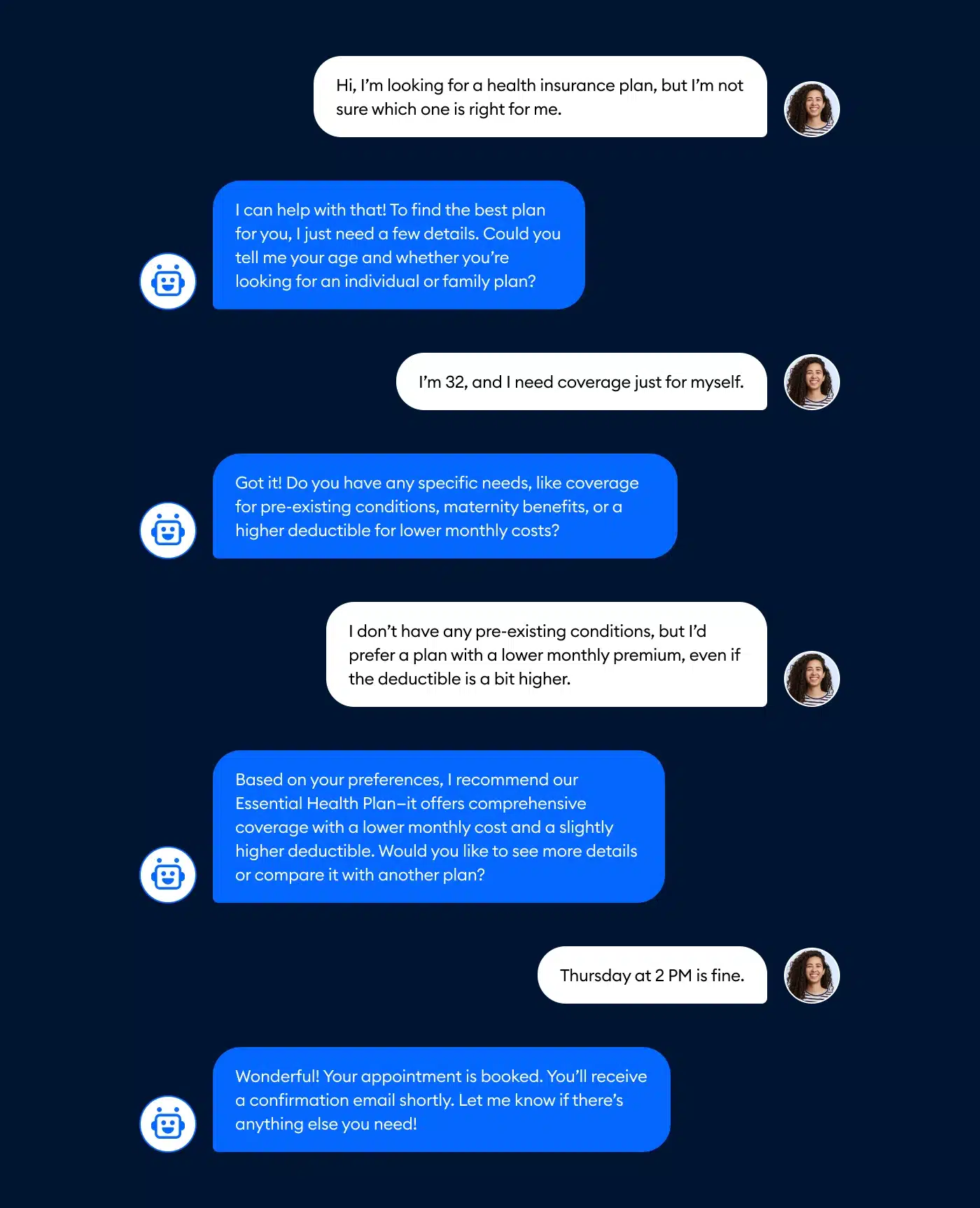
In the insurance space, this same AI-powered approach enables chatbots like Lyro to explain plans and policies in simple terms. It also helps qualify customers and can do a comprehensive price breakdown, eliminating doubt while choosing a plan.
Read more: Check out the best chatbot use cases.
2. Pre-qualifying customers
AI chatbots make sure that your insurance sales agents only speak to serious buyers. Before connecting a customer, chatbots can collect essential information to determine eligibility for specific policies, saving time for both customers and insurance providers.
For example, a home AI insurance agent might ask about the property’s size, location, and security to assess eligibility. That way sales representatives can discuss a customer’s options without having to personally do a full audit of their situation.
Tidio’s AI-powered agent uses retrieval-based responses to pull relevant information from connected data sources, ensuring customers receive accurate, real-time answers. This means it can pre-qualify insurance customers by gathering key details—such as age, vehicle type, or travel destination—and use that data to suggest policy options.
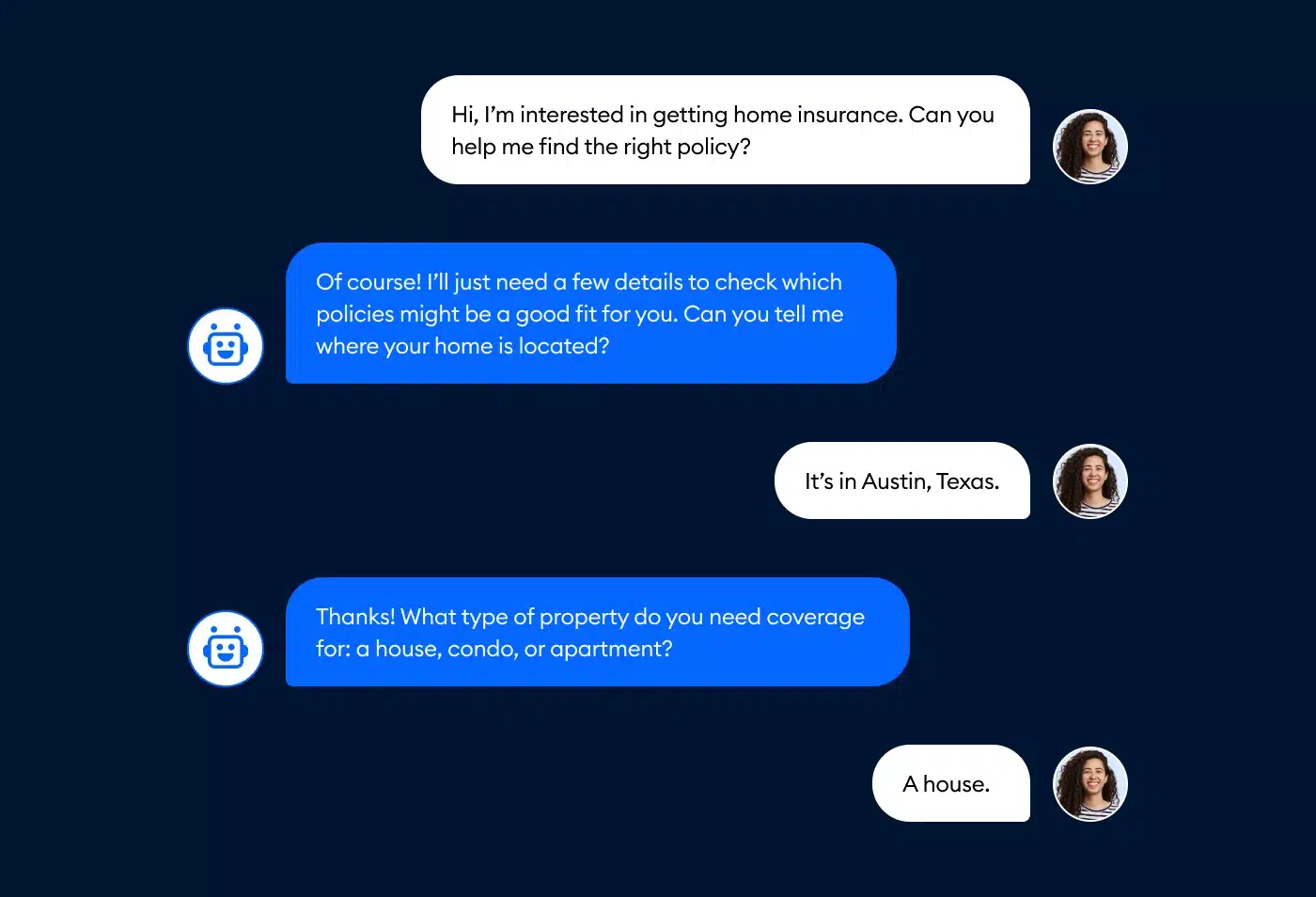
Tidio also offers agent routing, which makes it easy for Lyro to forward specific requests to agents within a certain department. That way your insurance agents only speak to the customers who truly need their expertise, improving efficiency and customer satisfaction.
Read more: Find out more about Lyro’s data sources. Also, be sure to check out tips for building a solid knowledge base chatbot.
3. Earning more leads through proactive engagement
You don’t know when new visitors are landing on your website, but an AI insurance chatbot does. It can proactively reach out to potential customers, offering assistance with plan selection and answering questions, converting interest into leads.
A chatbot on an insurer’s website might initiate a conversation with a visitor browsing life insurance policies, offering help with FAQs and prompting the user to request a personalized quote, thereby capturing leads effortlessly.

Lyro enhances this process with Custom Tasks. This allows insurers to engage website visitors based on their browsing behavior and intent. For example, if a visitor spends time comparing health insurance plans, Lyro AI can trigger a proactive chat message like, “Looking for the best health coverage? I can help you find the right plan based on your needs!”
Read more: Find out all you need to know about proactive customer service.
4. Providing comprehensive price breakdowns
As part of the qualification process, a chatbot in insurance presents detailed cost breakdowns of insurance plans. This includes premiums, deductibles, and additional fees, helping customers choose options that fit their budgets.
For instance, a chatbot could generate a side-by-side comparison of two auto insurance plans, highlighting monthly costs, coverage limits, and potential discounts, enabling the customer to make a well-informed decision.
Lyro helps with this process by dynamically retrieving and presenting pricing details based on customer preferences. If a user is comparing multiple policies, Lyro can outline key cost differences, explain how various factors affect premiums, and suggest money-saving options such as bundling policies or adjusting deductibles.
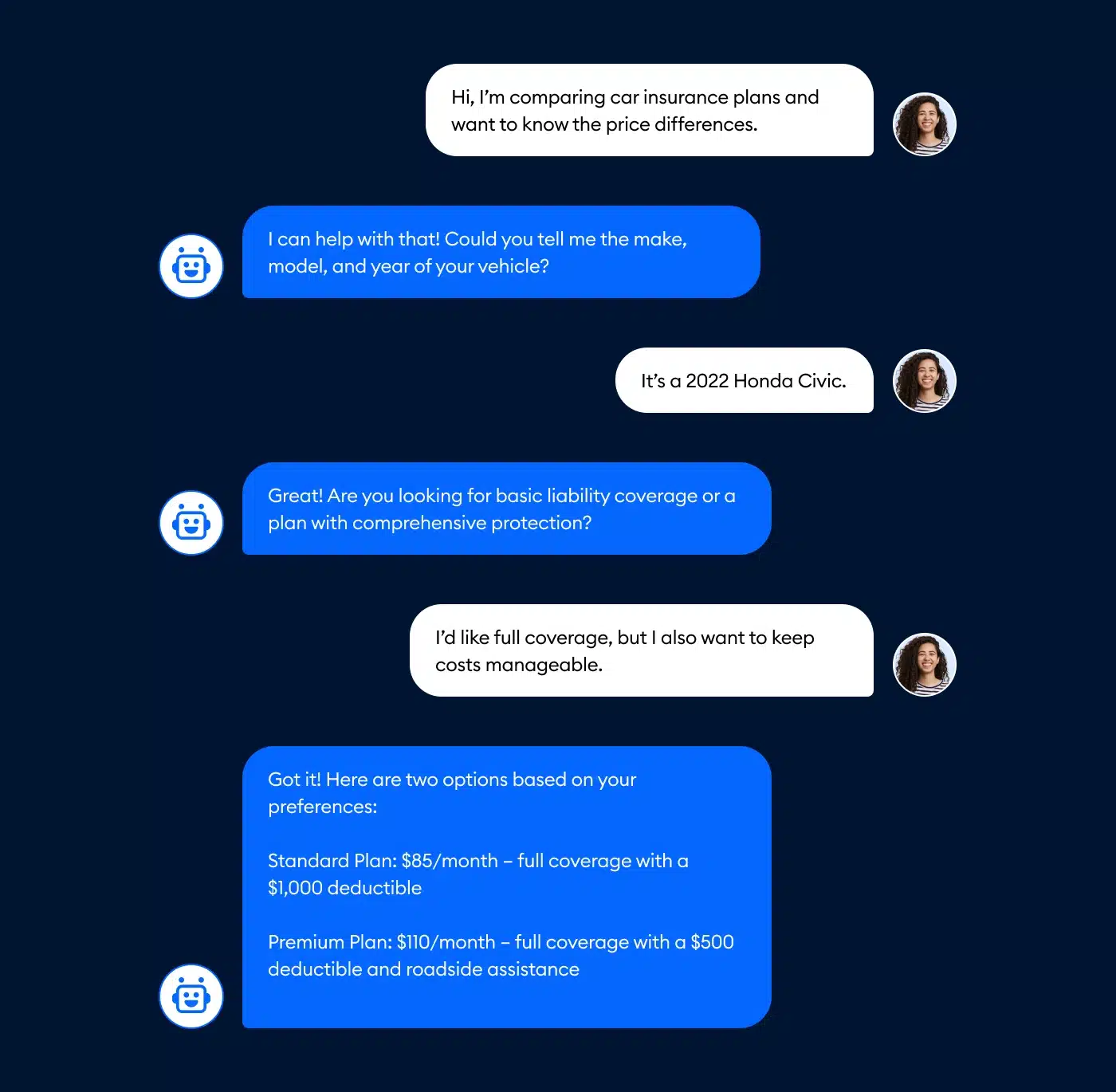
This allows your customers to easily evaluate their choices without analyzing complex policy documents.
5. Policy information and management
Chatbots have instant access to policy details, like coverage and renewal dates. This allows customers to manage their policies and request modifications without agent intervention. A chatbot could assist a policyholder in retrieving their insurance card, updating their address, or even modifying their coverage, all within a few minutes.
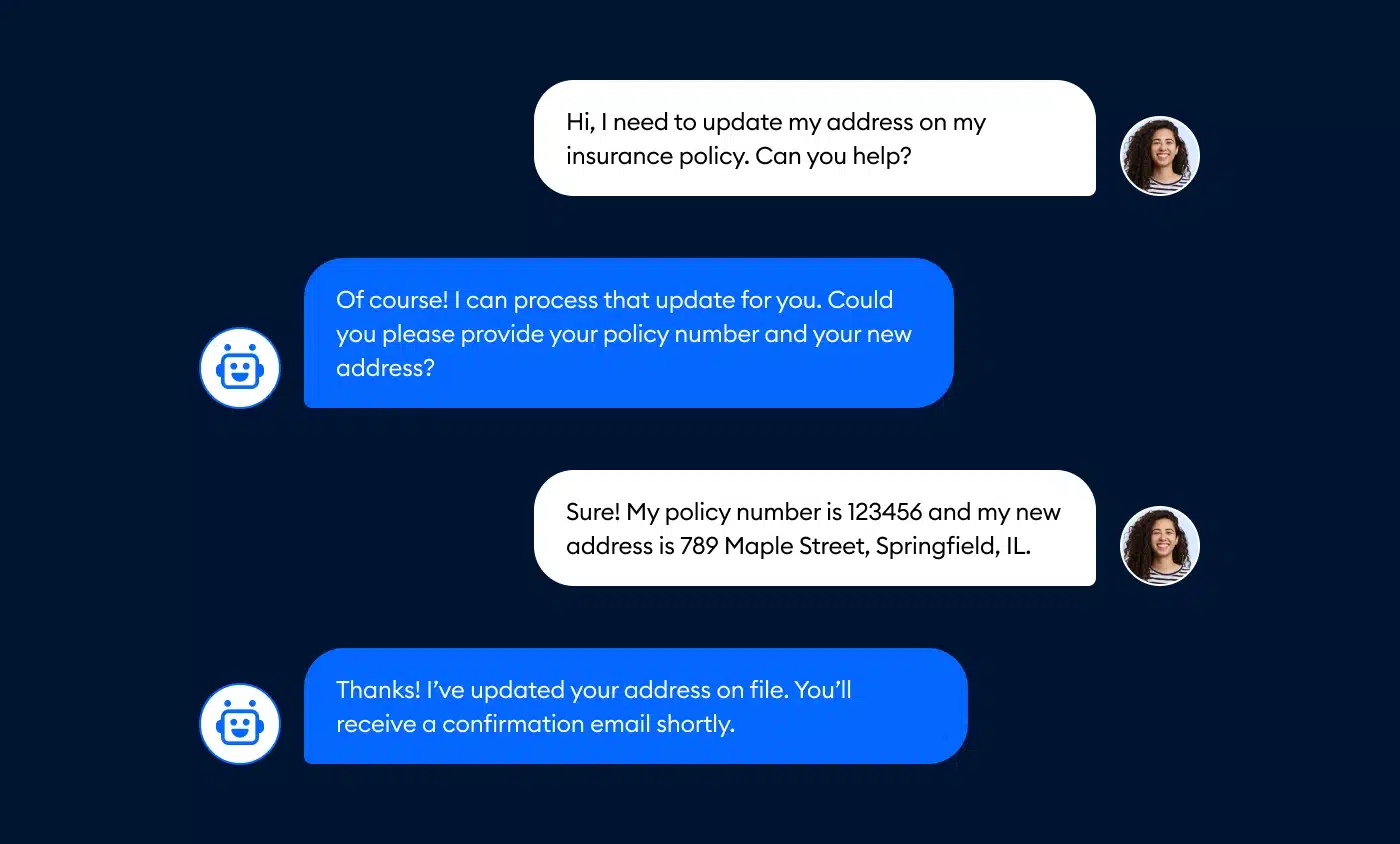
6. Claims processing
Filing insurance claims is more efficient with chatbots. They can guide customers through submissions and provide real-time updates on claim statuses and required documentation.
For example, a chatbot might help a user report a car accident by asking for key details like the location, photos, and driver information. Then, it submits the claim and provides status updates throughout the process.
7. Quote generation
By collecting key customer information, chatbots generate instant insurance quotes, helping users compare policy options and understand coverage terms with ease.
For example, a chatbot could ask for a user’s vehicle type, driving history, and location to generate several auto insurance quotes, allowing the user to select the best option.
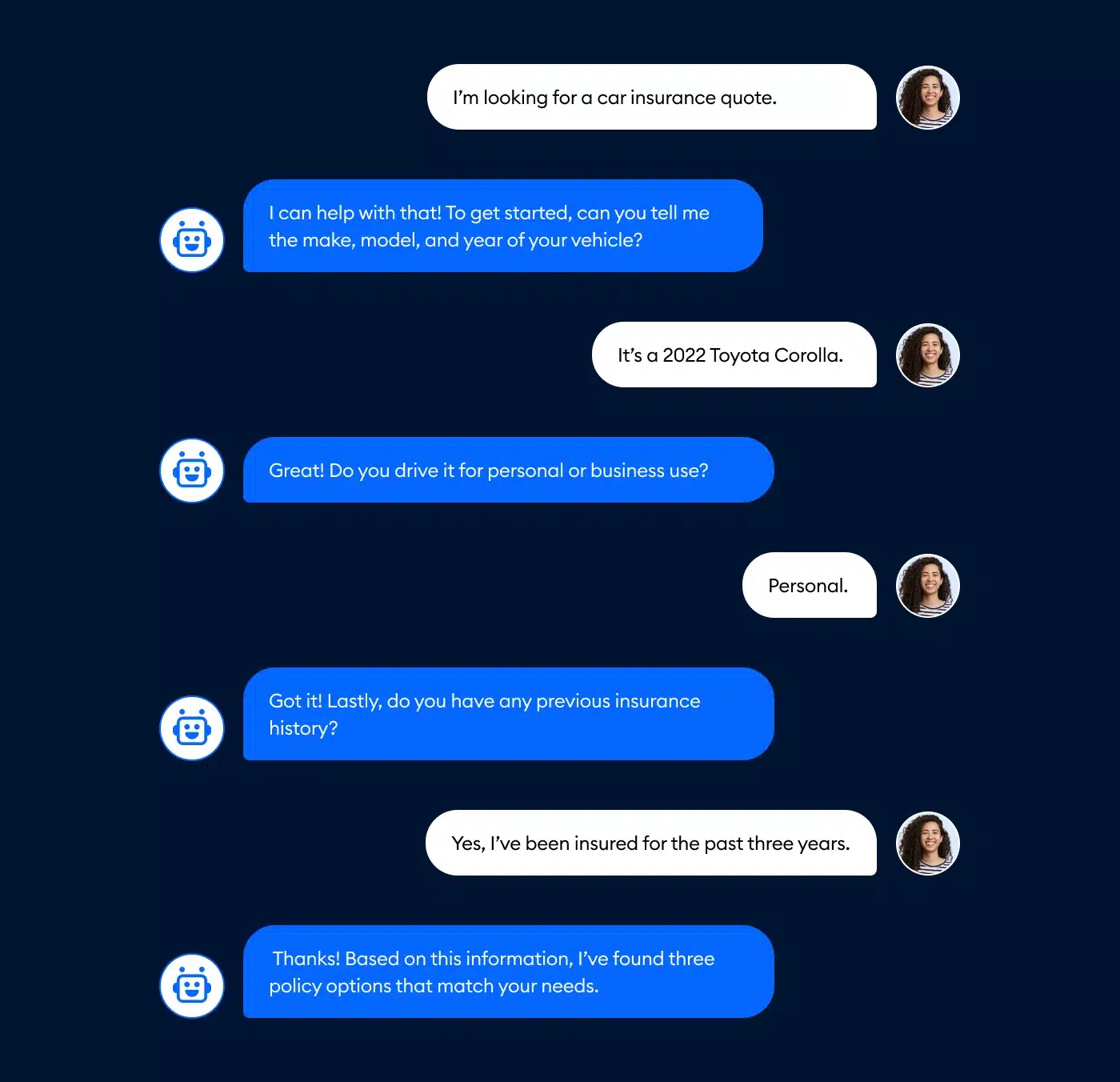
By offering instant quotes, visitors can quickly and easily compare plans to make a decision.
8. Fraud detection
AI-powered chatbots can analyze claim data to detect suspicious activity, helping insurers identify potential fraud early. The chatbot is able to escalate high-risk cases to human agents for further review while ensuring legitimate claims are processed.
For example, an insurance chatbot might flag inconsistencies in a travel insurance claim, such as conflicting travel dates or unusual expense reports. After, it can alert the fraud investigation team for further inspection.
Insurance chatbot examples
Insurance companies are increasingly turning to AI chatbots to streamline operations and improve customer experiences. From handling routine inquiries to managing complex processes like claims and policy updates, these chatbots showcase the versatility and value AI brings to the industry.
Let’s take a look at real-world examples of insurance AI chatbots in action. These demonstrate how they help insurers deliver personalized service while optimizing internal workflows.
IEC Insurance
IEC Insurance is a travel insurance company for Australian & New Zealand travelers to Canada. They use Tidio’s AI agent, Lyro, to assist site visitors with questions about their policies and provide quick and reliable support.
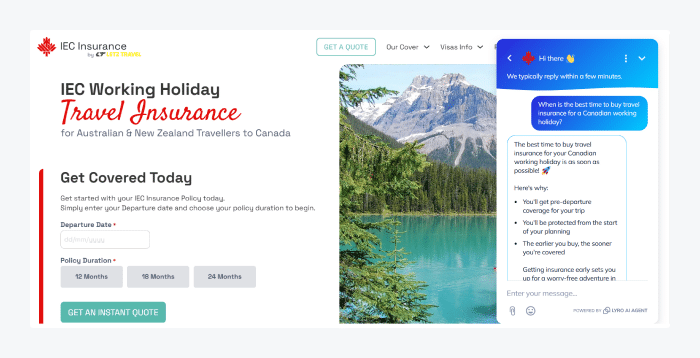
Lyro helps travelers navigate key aspects of IEC insurance, from understanding coverage for luggage and personal belongings to learning about emergency dental care. It also directs users to the full policy details or customer service for more specific information.
In addition, our Lyro AI agent helps travelers with frequently asked questions, like determining the best time to purchase insurance and get pre-departure coverage. By automating these routine inquiries, Lyro enables IEC Insurance to provide 24/7 assistance while freeing up human agents to handle more complex cases.
Varma
Varma, a prominent Finnish pension insurance provider, has implemented an AI chatbot named Helmi to enhance customer service. Developed using the GetJenny platform, Helmi is there to assist customers round-the-clock, effectively addressing common questions related to pensions and financial services.
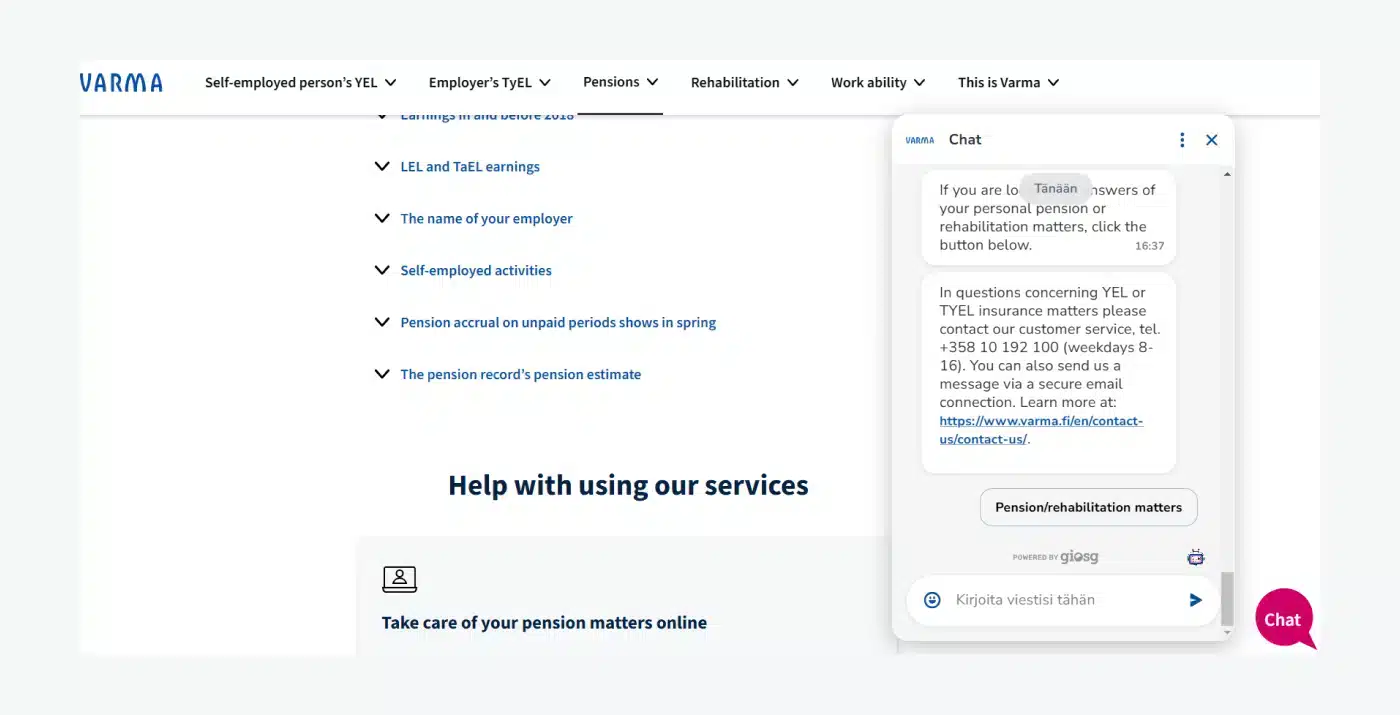
By handling routine questions, Helmi enables Varma’s customer service professionals to focus on more complex tasks, thereby improving overall service quality.
SWICA
SWICA, a leading Swiss health and accident insurance provider, uses IQ, an AI-powered chatbot designed to boost customer service. IQ utilizes artificial intelligence to address inquiries about SWICA’s product offerings, key healthcare information, and company details.
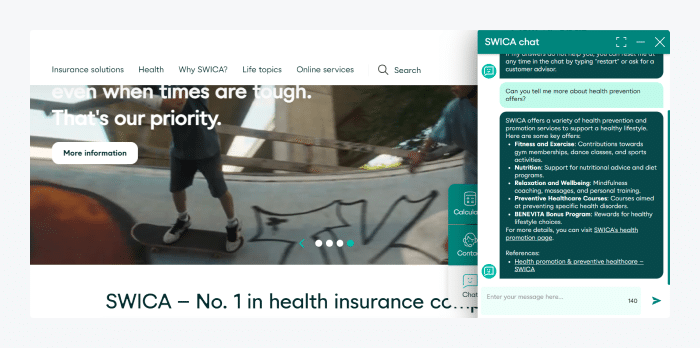
This initiative aligns with SWICA’s commitment to continuous digital advancement and ensuring 24/7 accessibility for its customers.
When this health insurance chatbot encounters a question it cannot answer, it prompts users to rephrase their query and offers the option to connect with a live SWICA customer support representative.
Common challenges of using insurance chatbots
While insurance bots offer numerous benefits, it’s important to be aware of the challenges that can occur during chatbot implementation and usage. Being mindful of these obstacles helps insurers address them proactively.
In this section, we’ll explore common challenges and share practical tips to overcome them for a seamless chatbot experience.
Data privacy and security
Challenge: Protecting sensitive customer data and ensuring compliance with regulations like GDPR and HIPAA is a top priority. Failure to do so can lead to legal repercussions, financial losses, and damage to customer trust.
Tip: Implement robust encryption protocols, regular security audits, and clear data handling policies to safeguard customer information. Ensure that chatbot interactions comply with industry regulations like GDPR and HIPAA when necessary, and provide transparency on how customer data is stored and used.
Handling complex queries
Challenge: Chatbots may struggle with complex or sensitive issues that require human judgment. Without proper escalation paths, customers might feel frustrated when their issues aren’t resolved efficiently.
Tip: Integrate seamless handoff to human agents for inquiries that go beyond the chatbot’s scope, ensuring customers receive the right support when needed.
Maintaining human touch
Challenge: Over-reliance on automation can make customer interactions feel impersonal. Customers still value human empathy, especially when dealing with sensitive topics like claims or disputes.
Tip: Use chatbots to provide personalized recommendations, address customers by name, and incorporate empathy-driven responses to create a more human-like experience.
Read more: Learn what makes a compelling chatbot persona.
Unlock the full potential of insurance chatbots
For insurance providers looking to enhance service quality and scale their operations, integrating chatbots is no longer optional—it’s a strategic move for growth.
With the right conversational AI solution for insurance, you can improve response times, reduce costs, and offer 24/7 support without compromising on quality.
Tidio’s AI agent, Lyro, offers all these benefits and more. From handling customer inquiries and managing policies to automating claims processing, Lyro is designed to streamline your operations while delivering exceptional user experiences.
Getting started is simple. Sign up for Tidio, customize your chatbot to reflect your brand and services, and integrate it with your existing tools like your CRM and other platforms. Don’t worry about the technical side—Tidio’s team is here to guide you through every step of the implementation process, ensuring a smooth and hassle-free setup.
Ready to see how Lyro can transform your insurance agency? Try Tidio for free today and take the first step toward smarter, more efficient customer support.



